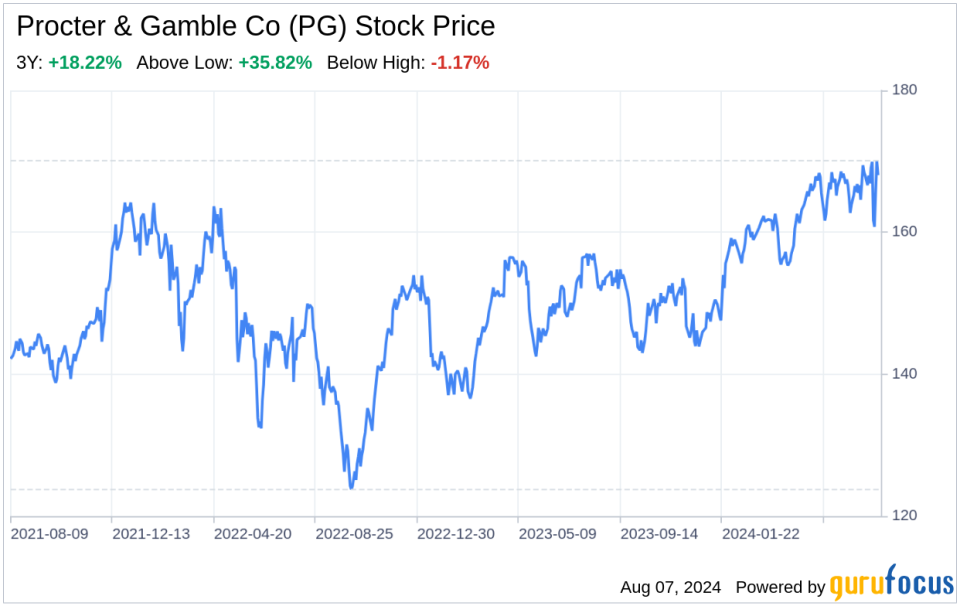Decoding Procter & Gamble Co (PG): A Strategic SWOT Insight
Procter & Gamble Co (NYSE:PG) showcases robust financial performance with net sales growth and strong operating income.
PG's diverse product portfolio and significant market share positions it as a leader in consumer goods.
Strategic focus on innovation and sustainability aligns with evolving consumer preferences and regulatory landscapes.
Global presence and reliance on international markets expose PG to currency fluctuations and geopolitical risks.
On August 5, 2024, Procter & Gamble Co (NYSE:PG) filed its 10-K report, revealing a financial snapshot of resilience and strategic growth. The company, a titan in the consumer goods industry since 1837, reported net sales of $84,039 million, a slight increase from the previous year's $82,006 million. Operating income also saw an uptick to $18,545 million, demonstrating PG's ability to maintain profitability amidst market challenges. With a diverse array of leading brands and a global footprint, PG continues to navigate the complexities of the consumer goods sector with a clear strategic vision.

Strengths
Brand Portfolio and Market Leadership: Procter & Gamble Co (NYSE:PG) boasts a formidable brand portfolio, with over 20 brands generating more than $1 billion each in annual global sales. This brand power is a testament to PG's deep market penetration and consumer trust. The company's leadership in various product categories, such as laundry detergents, baby care, and feminine care, is underpinned by iconic brands like Tide, Pampers, and Always, which command significant market shares. For instance, PG holds over 35% market share in the global fabric care market, primarily driven by Tide and Ariel. This strength is not just a reflection of PG's marketing prowess but also its commitment to quality and innovation, ensuring that its products meet the evolving needs of consumers.
Financial Performance and Operational Efficiency: PG's financial health is robust, with net earnings attributable to Procter & Gamble standing at $14,879 million, showcasing the company's ability to translate sales into profits effectively. The increase in net earnings per common share from $5.81 in 2022 to $6.02 in 2024 indicates a strong return on investment for shareholders. PG's operational efficiency is further highlighted by its focus on productivity improvements, which fuel investments in research and development (R&D) and marketing, driving value creation and sustainable growth.
Weaknesses
Dependence on Global Markets and Currency Risks: While PG's global presence is a strength, it also presents inherent risks. With more than 50% of its annual net sales generated outside the U.S., PG is susceptible to foreign currency fluctuations and geopolitical uncertainties. The 10-K filing notes that currency exchange rates can significantly impact the U.S. dollar value of sales and earnings, potentially eroding PG's financial results. Additionally, the presence of currency exchange, import authorization, and pricing controls in some markets could adversely affect PG's operations and financial outcomes.
Competitive Pressures and Retailer Concentration: The consumer goods industry is fiercely competitive, with PG facing challenges from both global and local competitors, including private-label brands. The company must continuously innovate and adapt to maintain its market share and profit margins. Furthermore, the concentration of retail customers, such as Walmart Inc., which accounts for approximately 16% of PG's total sales, creates significant bargaining power for these retailers. This could lead to cost and margin pressures, potentially impacting PG's business performance if trade terms and principles are not mutually agreeable.
Opportunities
Innovation and Sustainability Initiatives: PG's commitment to innovation is evident in its product development and sustainability efforts. The company's focus on superior product features, packaging, and responsible sourcing aligns with consumer trends towards environmentally friendly products. PG's investment in water restoration projects and efficiency improvements in water usage demonstrates its proactive approach to sustainability, which can enhance brand reputation and appeal to a growing segment of eco-conscious consumers.
E-commerce and Direct-to-Consumer Platforms: The rise of e-commerce and social commerce presents significant growth opportunities for PG. By leveraging online platforms and direct-to-consumer channels, PG can expand its reach, personalize consumer experiences, and gather valuable data to inform product development and marketing strategies. The company's strategic focus on these emerging retail trends positions it well to capitalize on the shift in consumer shopping behaviors.
Threats
Macroeconomic Conditions and Financial Risks: PG's operations are subject to macroeconomic risks, including inflationary pressures, economic downturns, and changes in trade policies. These factors can lead to reduced demand for PG's products, increased supply costs, and financial hardships for customers and business partners, potentially impacting PG's financial health and operational stability.
Regulatory and Legal Challenges: As a global entity, PG must navigate a complex regulatory landscape that includes intellectual property, product safety, environmental protection, and data privacy laws. Compliance with these regulations is crucial to avoid legal repercussions and maintain consumer trust. The company's 10-K filing acknowledges the ongoing costs and complexities of compliance, which could impact its operations and financial results if not managed effectively.
In conclusion, Procter & Gamble Co (NYSE:PG) presents a compelling case of a well-established company with a strong brand portfolio and solid financial performance. Its strategic focus on innovation and sustainability aligns with current consumer and regulatory trends, offering pathways for growth. However, PG must remain vigilant in managing the risks associated with global market dependencies, competitive pressures, and regulatory compliance. By leveraging its strengths and addressing its weaknesses, PG is poised to capitalize on opportunities and mitigate threats, ensuring its continued leadership in the consumer goods industry.
This article, generated by GuruFocus, is designed to provide general insights and is not tailored financial advice. Our commentary is rooted in historical data and analyst projections, utilizing an impartial methodology, and is not intended to serve as specific investment guidance. It does not formulate a recommendation to purchase or divest any stock and does not consider individual investment objectives or financial circumstances. Our objective is to deliver long-term, fundamental data-driven analysis. Be aware that our analysis might not incorporate the most recent, price-sensitive company announcements or qualitative information. GuruFocus holds no position in the stocks mentioned herein.
This article first appeared on GuruFocus.